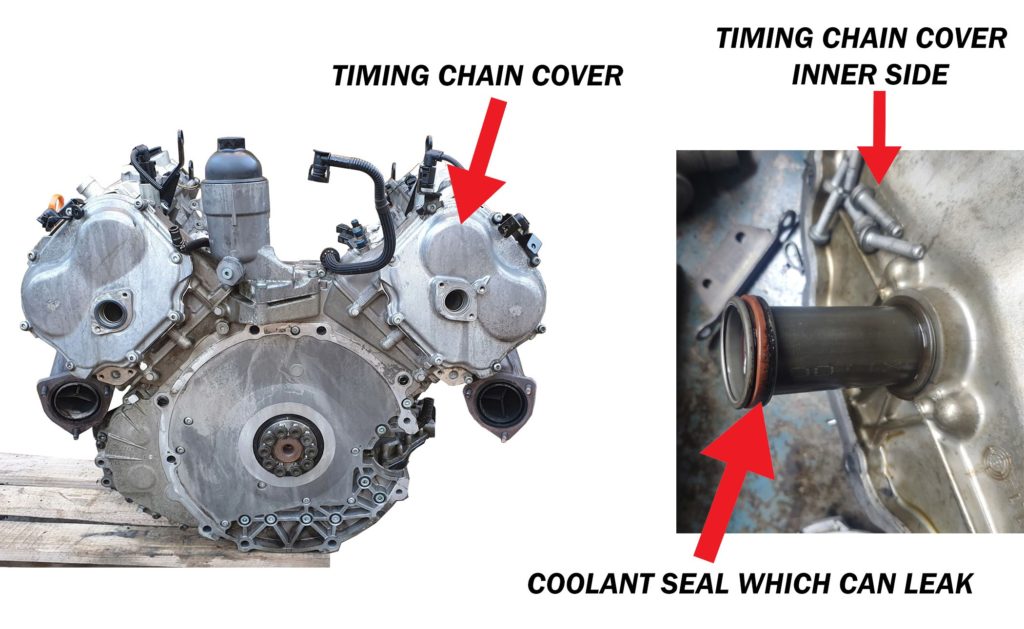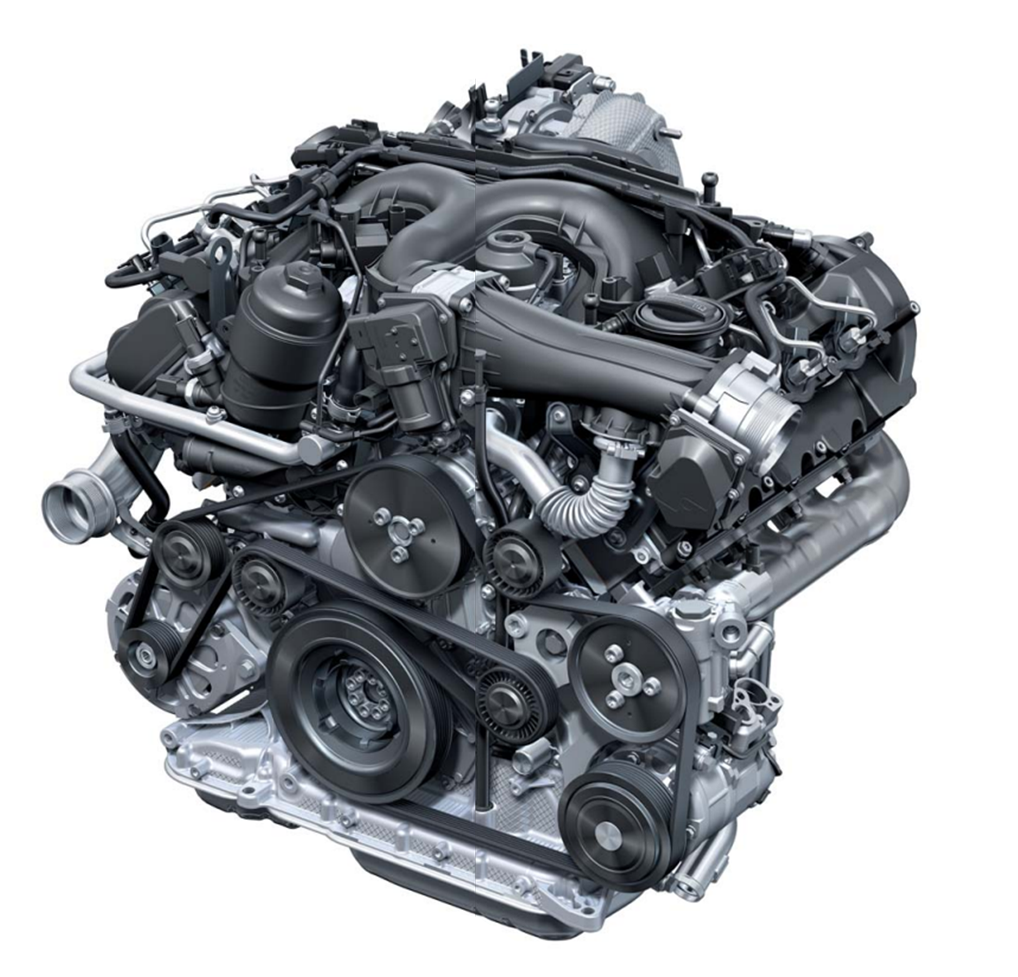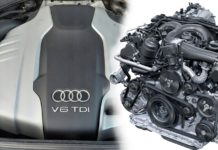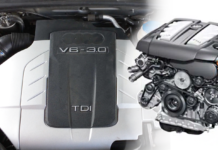Petrol engines

carbon build up & faulty injectors
All the petrol engines are equipped with direct injection, so the well known problems with carbon build up or faulty injectors will occur. Ignition coils can fail as well-causing misfires, but this is nothing new.
-Every 200 000 km it’s good to check the intake valves for carbon build up / eventually clean them. At this mileage there can be already a noticeable amount of carbon on the intake valves – but this of course depends on how the previous owner used the car and how often he changed the oil.
Excessive carbon build up symptoms: cold start misfires, misfires in general.
-Every 200 000 km it’s good to check the injectors too. The injectors should be fine up to approx. 200 000 km, but at this mileage point it’s good to check them / test them / or replace them preventively.
Faulty/clogged injector symptoms: misfires in general, jerking during acceleration, in worst case the injector can get stuck in closed or open position-overfueling the cylinder or causing damage to the catalytic converter for example.
cam adjustment solenoids
Mainly the 3.6 l and the 4.2 l engines can have faulty camshaft adjustment solenoids. Usually they get stuck because of long oil change intervals → in this case you get fault codes for the camshaft position, misfires or fluctuating/bouncing idle.
The 6 cylinder engines have two of them and the 4.2 l V8 has 4 of these solenoids, but interestingly replacing them is much easier on the V8 engine than on the 3.6 l motor. Sometimes you can get slight oil leak from them as well, but in this case there is no need to replace them completely, you just need to change a small o ring on them.
3.6 FSI
Oil pump bolt
The 3.6 l, 6 cylinder engine is not bad, but in cars made to 2007 it can have issues with the oil pump bolt. Basically, the oil pump sprocket bolt can break or it just becomes loose over time causing loose sprocket → loose timing chain and in the worst case → a destroyed engine! This is not extremely common, but it can sometimes happen on low mileage as well as on high mileage cars. They say that the bolt they used is not strong enough + it was not torqued properly from the factory on some cars. Interestingly, cars made from 2008 do have updated stronger oil pump bolt so they won’t have this issue.
All in all, if you want to preventively change this bolt on cars made to 2007 then you can – but you have to remove the engine to access it, so keep extra money for this.
HPFP
This engine has one high pressure fuel pump. The pump itself is usually fine, but as it gets older at some point it will slowly start to leak fuel from the solenoid valve on the side. The same pump is mounted on the 4.2 FSI engine so more info about this you can find below.
4.2 FSI
Then there is the 4.2 l V8 FSI which can have some more issues (detailed article about 4.2 V8 issues)
HPFP
This engine has two high pressure fuel pumps which are located on the top of the engine, so replacing them is pretty easy and they usually don’t fail completely. However at some point they will slowly start to leak fuel from the solenoid valve which is bolted onto these pumps. You can’t buy just the genuine/OEM solenoid unit itself as a spare part, so if you want to fix this with genuine/OEM parts you have to buy the complete pump which costs around $300. ON the other side you can buy a cheap Chinese solenoid unit itself and replace it separately (But how long will it work? Who knows.)
If one of the pumps starts to leak then don’t worry, because the other will sooner or later leak as well. So long story short, you should definitely occasionally check them, since in some cases they started to leak even after 140 000 km. high pressure fuel pump fuel leak location video
Rarely the HPFPs can fail too, causing: bad/rough engine start and rough idle.
Oil & coolant leaks
This engine will have many oil and coolant leaks. Some of them are pretty easy to fix but some of them like the rear timing chain cover leak or the spark plug tube seals leak are not easy to fix !! In some cases-because of the lack of space the mechanics simply remove the whole engine to fix certain leaks (because that way it’s actually easier).
Coolant leak which can kill the 4.2 FSI engine
The rear timing chain covers of this engine do have a hole in them thru which the coolant flows. This would be fine, but it’s not. It’s not fine, since the coolant seal on these covers can fail and let the coolant leak directly into the engine-into the oil. Long story short: If you don’t catch this early then you will end up with a destroyed engine.

Variable intake manifold
There is a variable intake manifold mounted on top of this engine which helps to increase the power, but it is a complicated piece of shit. And why? Well, mainly because of the plastic insides, but long story short:
- the inside of the intake manifold gets dirty over time
- the plastic bits in it are gonna get brittle – break – and fall apart (eventually the bits can be sucked into the cylinders IN THE WORST CASE-so rarely)
- the 2 electric actuators mounted on front of the manifold can fail too
However cars made from 2009 (very late 2008) have an updated more simpler plastic intake manifold which should not cause issues. /the old problematic intake manifold is made from aluminum & magnesium alloy, the newer reliable is made from plastic/
Overall I would recommend to keep at least $6 000 if you want to choose this engine.
The only good thing is, that most of these issues are gonna occur usually just after 200 000 – 250 000 km.
In this engine you should be prepared to change the timing chain and the plastic guides too – after 200 000 km, but I will come back to this topic a little later.
3.0 TFSI
This engine doesn’t have any extraordinary issues, except:
- direct injection related problems
- leaking water pump
- it can have issues with oil consumption
- the PCV housing can crack and let the coolant into the engine oil – So it’s better to replace it preventively !
Lastly, it’s important to:
- check all the fluid levels before buying
- check the coolant: it has to be topped up, clean and pink without any oil smell or oil traces (check the coolant only while the engine is cold !!!)
- start the car when it’s cold and check for an uneven idle or shaking which indicates misfires, the engine has to run smoothly all the time
“All petrol engines: expect vacuum leaks and faulty PCV.”
“All petrol engines: the exhaust flexible pipe will break at some point so check it before buying.”
Diesel engines

3.0 TDI
This Q7 was available with 3 types of the 3.0 TDI V6 diesel engine:
- 3.0 TDI (BUG, BUN engine code) oldest 1st gen
- 3.0 TDI (CA…, CC… engine code) newer 1st gen
- 3.0 TDI (CJ…, CR…, CL…, CN… engine code) 2nd gen
1st gen 3.0 TDI (BUG, BUN, CA…, CC…)
detailed video of ALL Issues of the 1st gen 3.0 TDI

This is the oldest-first version of the 3.0 TDI engine. The BUG, BUN engine code version is the oldest type which you can recognize by the plastic intake manifold. However there is also a newer version with the engine code which starts with CA or CC. This newer type has a metallic intake manifold and a newer fuel injection system. Other than this it’s essentially the same engine with only some very minor differences. Thats why these engines have almost the same issues:
variable intake manifolds
-The variable intake manifold flaps are gonna fail at some point. The flaps can be stuck, loose or the actuator motors can be faulty. In this case you get only a check engine light, so the car will drive fine. The whole intake manifold part is obviously expensive but you can find repair kits for a much reasonable price + you can buy the actuator motors separately as well.
crank pulley
-It’s also good to check and eventually replace the crankshaft pulley vibration damper mainly in cars which were used on winter salty roads. Since over time the inner part of the pulley will rust out and separate from the outer part. This will leave you stranded because the accessory belt will jump off so it’s better to check this pulley before you will wonder what the hell happened.
oil leaks
The common oil leaks of these engines are related to the:
- valve cover gaskets
- upper injector seals
- rear main seal (usually engine out to fix)
- rear timing chain covers (usually engine out to fix)
- oil filter housing seals (between the cylinder heads)
- oil cooler seals (between the cylinder heads on high mileage cars)
coolant leaks
The common coolant leaks of these engines are related to the:
- specific o-rings near the EGR cooler (between the cylinder heads)
- tiny plastic pipe on top of the engine
- the thermostat and water pump are gonna leak at some point (but this is nothing special)
check the coolant before buying
Lastly there are occasionally cases of cracked cylinder heads or leaking head gaskets on these V6 units. In my opinion it’s because the owners don’t wait until the engine is warmed up properly and since this is not the most powerful engine and the Q7 is heavy, they rev the engine a lot when it’s still cold → and this can result in the already mentioned issues. Because of this I would highly recommend to at least check the coolant while the engine is still cold. It has to be clean, topped up and you shouldn’t see any oil in it.
With a cold engine look into the coolant tank with a lamp and also smell the coolant for oil. If the coolant is not pink and clean, and if there are traces of oil → then just walk away.
2nd gen 3.0 TDI (CJ…, CR…, CL…, CN…)
detailed video of ALL Issues of the 2nd gen 3.0 TDI
This is the new 2nd gen version of the 3.0 TDI engine. This newer type has:

- a different looking plastic intake manifold
- more plastic parts
- different layout on top of the engine
- newer timing chain design
- an updated fuel injection system
The engine code of this version starts with CJ, CR, CL or CN. On these engines you can expect similar but slightly different issues than on the older 3.0 TDI versions:
popped out fuel injectors
There are cases of popped out fuel injectors because of the snapped bolt on the injector in cars which have more than 100 000 km. So, it’s good to occasionally check these bolts or preventively replace them if you want.
crank pulley
Check and eventually replace the crankshaft pulley vibration damper, since over time the inner part of the pulley will rust out and separate from the outer part-the same way as on older 3.0 TDI engines.
oil & coolant leaks
These engines are prone to various leaks as well, so be ready for oil and coolant leaks because of failed seals/o-rings located between the cylinder heads. + there is also a plastic coolant valve located between the cylinder heads which will leak coolant sooner or later. Fixing these leaks is not the easiest since you will have to remove almost everything from the top of the engine which is pretty time consuming. + The rear timing chain covers and the rear main seal can leak oil as well – usually engine out to fix both of these leaks.
4.2 TDI
The 4.1 l V8 TDI is a pretty damn good engine actually, and it’s also reasonably reliable. So if you want enough power to overtake most of the cars on the road, but you also want an acceptable fuel consumption then choose this engine. If it’s maintained properly and used mainly on longer journeys then it can easily withstand 400 000 km without major repairs. BUT it is a big and complex engine so fixing the various leaks and replacing the turbochargers is not gonna be the cheapest, because in most of the cases they will remove the whole engine to fix them. To top of that this engine has 2 turbochargers which can withstand a lot, however be ready that in cars which have more than 300 000 km or in the more abused cars they will fail.
6.0 V12
Apart from the regular diesel engines for peasants there is also the rare, impressive and insane 6.0 l V12 TDI. The reliability of this V12 is basically the same as the reliability of the V8 – so it doesn’t have unexpected major problems and it can reach 400 000 km without major repairs. Just keep in mind that:
-it has 12 injectors and 2 high pressure fuel pumps (this stuff is gonna fail at some point: one new injector – 700 € x12)
-there is a bigger chance that the previous owner abused it, which can result in various surprise issues like: leaking head gasket, cracked cylinder head or prematurely worn turbochargers
-if it will leak oil or coolant then most probably the engine will have to come out to fix those leaks, because there is not much space around the engine
-cars equipped with this engine have carbon-ceramic brakes as standard which can withstand 250 000 km or even 300 000 km, but they can crack and are very expensive to replace (19 000 € to replace all the discs and pads) However you can convert these brakes to regular steel brakes.
-because of the additional few hundred kg of engine weight and because of the huge wheels which are fitted on these models standardly, the suspension components (bushings, control arms or wheel bearings) are gonna be worn earlier than on the models with the regular engines
+most of the mechanics have never seen this engine (not even on a picture), so they will refuse to work on it
All in all, most of these V12 cars currently for sale have around 200 000 km. If you want to buy one with a mileage like this then:
- check properly the engine for leaks
- make sure there is no smoke from the exhaust at idle or at acceleration after warming up – which will indicate faulty injectors
- at this mileage keep extra money to replace the injectors and turbochargers
- check the remaining life of the brakes, check them for damage and keep extra money for at least the brake pads / or be ready to convert them to regular steel brakes
- check the coolant – it has to be clean without oil traces or oil smell
- the engine has to work perfectly smooth all the time
If the car is in good condition, then with the proper maintenance and use it can most probably withstand another 50 000 km – 100 000 km without big issues (and you can tow space shuttles with that much power).
Faulty Injectors + HPFP
All diesel engines can have/are gonna have faulty injectors at some point – usually after 200 000 km be ready for this failure. In this case you can most of the time notice a couple of signs like the: occasional light grey smoke from the exhaust while acceleration or at idle, and also a slightly bouncing idle/fluctuating RPM when the engine is warmed up, eventually issues when starting the engine-long cranking and shit.
If you want to prolong the lifetime of the injectors and high pressure fuel pump, then it’s really important to use only high quality premium diesel fuel/eventually some good quality additives.
CP4 high pressure fuel pump failure
All the newer diesel engines (except the oldest 3.0 TDI – BUG, BUN engine codes + 4.2 TDI with the BTR engine code) are equipped with the infamous CP4 high pressure fuel pump which can sometimes fail even after 150 000 km (MOSTLY JUST in Eastern EU or US). However it can also last more than 400 000 km, so it’s more or less a lottery and nobody knows when will it fail (it can last 150 000 km, 250 000 km but also even 450 000 km). If it fails it will throw small metal particles in the fuel system-thus destroying itself + the injectors and sometimes these particles will contaminate the fuel tank as well. More information about this failure in this BMW X5 article.
To minimize this issue:
- use premium good quality fuel / eventually fuel additives
- don’t drive with low fuel level
- change the fuel filter regularly
- replace it preventively
- remove and disassemble the HPFP to check the condition of the internal parts-if they do show signs of wear or not
- pray or hope that it won’t fail soon
Timing chain

All of the engines are equipped with timing chains. The tensioners and the plastic guides can be worn + the chain can be stretched a bit, but mostly just after 200 000 km. Now, in this case you get the well known short rattle at cold start so check for this rattle before buying!
But the funny thing is that there aren’t many catastrophic engine failures because of the timing chains. I’m not saying that there aren’t any at all because they are, but they really are not that common – at least amongst the diesel engines. (the petrol engines can more often end up with failed chain mechanism, at least in my personal humble experience)
In real life a good amount of owners with rattling chains can’t be bothered to replace them, so they are testing the chains lifetime this way. Although, again, I have to add that a rattling chain on a petrol engine is gonna most probably fail sooner than later!
All in all, the chain can rattle a month and then it can jump a teeth – making the engine run like garbage, or you suddenly end up with a destroyed engine. But it can also rattle for a couple of years without other problems-on the diesel engines. At the end of the day it’s up to you, if you want to push your luck with a rattling engine or not, but at 300 000 km I would definitely recommend replacing it if the car still has the original chain from the factory!
The timing chains are located on the back side of the engine so you have to remove the engine+gearbox to change them.

Transmissions
This Q7 can be equipped with the:
- older 6 speed automatic gearbox
- newer 8 speed automatic gearbox
- the 3.6 l petrol engine was available with a very, very, VERY RARE 6 speed manual as well
The automatic transmissions can usually withstand a long time – but check them properly before buying! They should change gears smoothly without slipping, hesitation or fluctuating RPM. After 200 000 – 250 000 km the torque converter can show signs of wear-mainly if the previous owner never changed the oil in the gearbox, or if the car was used a lot for towing (bad torque converter symptoms: fluctuating RPM, slipping, hesitation, shuddering/vibration at slight acceleration).
+check the automatic gearbox for oil leaks:
- the electric connectors on the 6 speed gearbox can leak – if they leak oil, then you will have to replace the wiring harness inside the gearbox since you can’t replace just the leaky connectors (over time the oil can in this case travel thru the wiring right into the gearbox control unit-located under the passenger seat and cause issues with the gearbox-rough shifts or limp mode)
- the pipes which go from the gearbox to the gearbox oil cooler can leak (mostly only on cars used on winter salty roads)
low gearbox oil level will cause issues with hard shifting, if ignored for a long time the gearbox will get damaged
Differentials & transfer case
It’s also important to check the fluid level in the differentials and change it regularly! The old or low differential fluid will kill the differentials over time.
+check/change the oil in the transfer case too since there are cases of transfer case failures which a regular oil change can minimize !
Power steering fluid
It’s a very good idea to occasionally replace the power steering fluid to prolong the lifetime of the power steering pump. +Also check the fluid level regularly, because the low power steering oil level will kill the pump over time.

The power steering fluid can also leak, so check the underside of the car for oil leaks and check the fluid level regularly!
On the attached picture there is a slight power steering fluid leak from a rubber hose – in this case the leak was caused by a loose hose clamp. But the power steering oil cooler mounted behind the front grill, or rarely the steering rack itself can sometimes leak oil too.
It’s also good to pay attention to the steering itself. During turning the steering wheel you should not hear any whining/humming/buzzing noises and you should not feel any vibration in the steering wheel. + During driving pay attention to knocking from the steering on bad quality roads which can indicate worn steering rack.
To summarize things up:
- from the petrol engines the 3.6 FSI is the most reasonable choice, the 3.0 TFSI is not the worst either but it’s more complex and not that durable
- from the diesel engines the most reasonable is the 3.0 TDI but if you have more money to spend then the 4.2 TDI is great
- check the car properly for traces of water/moisture in the interior
- buy only a car with a proper maintenance history
- find a good independent mechanic
- change all the fluids in time
- keep at least 3 000 € for the possible repairs, and if you are buying a car with more than 200 000 km then you should keep twice as much money
And if you have personal experience with this car or more information about it, then you can write it into comments!













